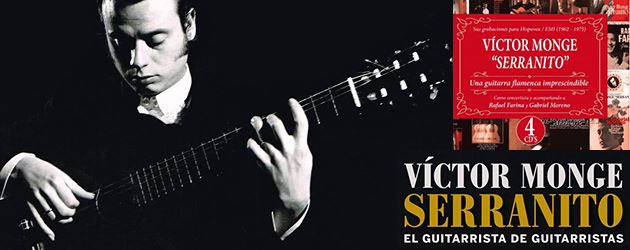José Manuel Gómez Gufi
Victor Monge Serranito. The guitarist of guitarists – José Manuel Gamboa (LIBRO+DVD) by José Manuel Gamboa – Review
If someone asked me what’s the most difficult and complicated work of all related to flamenco, I’d say “committing oral culture to paper”. It’s not just taking down people’s words, you also have to explain things with the voice of a listener who is seldom neutral. We owe a lot to José Manuel Gamboa, because he never gets tangled up in his opinions, and makes them quite clear so we can separate the grain from the chaff.
And there isn’t any chaff in these 456 pages. In fact, I ran into the author and warned him about his work, that it was becoming more and more voluminous, I told him it would be a good idea to summarize. I take that back, that’s a stupid thing to say. Not one thing is superfluous in this book, not even Victor Monge Serranito’s humility. Let me explain, the guitarist tells his story and that of many others. In this way we reconstruct the history of flamenco with each chapter. Serranito’s experiences as told by Gamboa. We relive how Victor was the first to put concert guitar in tablaos! And since his memory and faculties are perfect, he realizes when he’s already told a story before, and we make headway.
We get a cheeky account of how his beginnings in guitar were thanks to the two chords Carlos Montoya taught Victor’s father. Carlos Montoya, nephew of Ramón Montoya, made his career in the U.S. (and can be considered one of the pioneers of jazz flamenco with his improvisations in “St. Louis Blues”).
And Serranito continues with the sass when he tells how he was able to learn a falseta of Niño Ricardo’s in the middle of a bar bet. Gamboa defends the taverns against Andrés Segovia’s assertion: “I’ve redeemed the guitar taking it out of the taverns”. And in 1970 Andrés Segovia had the following to say about Serranito, in the former’s own handwriting where he more or less states: “he belongs to the noble tradition of flamenco while managing to avoid too many unmusical defects”. Victor clarifies that the maestro made him understand “I was an animal…I mean, he told me that humans are guided by intelligence…and only us animals are guided by intuition. And I was intuitive!” he laughs.
This, the book is a defense of the guitar as opposed to classical music. And Serranito became, in the nineteen-seventies, one of our champions of solo guitar in the triumvirate formed with Paco de Lucía and Manolo Sanlúcar.
WITH PACO
The reader knows that comparing yourself to Paco de Lucía can be a suicide mission for any guitarist, and that is one of the recurring issues –not a main one- in the book, inevitable in as much as Paco’s career is a bright light, and a reference for the topic at hand, that of concert guitar.
In the nineteen-sixties when he was about to sign with Philips, Serranito decided that since his main collaborations of the moment were with Hispavox, it made no sense to go with Philips, and he signed with Hispavox. Shortly afterwards, Paco signed up with Philips. If the reader wants to do some “flamenco fiction”, you can speculate about what would have happened if the roles were reversed. Serranito reflects on the past and regrets not having continued accompanying singing; “I made a mistake” he says firmly about this issue.
And then the crucial moment arrives. Paco had launched “Fuente y Caudal” in 1973, and it nearly went unnoticed until Jesús Quintero “El Loco de la Colina”, worked out an aggressive marketing plan for “Entre Dos Aguas” as a single in 1974, which remained number 1 on the charts for 27 weeks, the second most bought record in 1975, unprecedented success for a single, and in May of the same year, Manolo Sanlúcar released “Caballo Negro”, also with excellent market results, but Serranito?
“Jesús Quintero came looking for me, he wanted to launch me and Paco”, but Serranito was on his way to Mexico to attend to an earlier commitment, precisely the day the deal was to be signed…and when he returned, everything was wrapped up. Paco is a pop star and his path is laid out. In 1976, Serranito launched his single with Columbia, “Junto al Mar”, somewhat less popular.
Nevertheless, you can’t get too carried away by the success. Paco was trying to avoid that strategy all throughout his life, and Sanlúcar suffered to no end because the record companies wanted singles, they wanted to repeat those successes that went viral. Jorge Pardo gives little importance to being in the eye of the hurricane with Paco: “We were there and we knew the pieces”.
So indulging in “flamenco fiction” is useless, and we now have Serranito still active and nearly all the guitarists who intervene at the end of the book highlight the contributions he’s made to guitar. Thirty pages of admiration and respect.
During the presentation at the Corral de la Morería, a veritable battalion of guitarists who were present came up on stage: Cañizares, José Antonio Rodríguez, El Amir and many others who wanted to see Victor show off another of his talents: dancing. And so it was that we saw these great guitarists clapping rhythm for Serranito’s dance bit. Unforgettable.
Yet, on the inside there was mourning as the night before Miguel Rivera, companion of a thousand battles, had passed away. The book is accompanied by a DVD that includes a guitar recital from 1987 with the second guitars of Miguel Rivera and Oscar Herrero. Warner has released the recordings from Hispavox/Emi (1962/1975) on 4 CDs.
Video presentation Corral de la Moreria – October, 2017:
